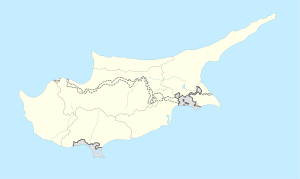Akrotiri (village)
|
Akrotiri Ακρωτήρι Ağrotur |
|
|---|---|
| Location in Cyprus | |
| Coordinates: 34°36′3″N 32°57′18″E / 34.60083°N 32.95500°ECoordinates: 34°36′3″N 32°57′18″E / 34.60083°N 32.95500°E | |
| Country |
|
| British Overseas Territory | Akrotiri and Dhekelia |
| Population (2001) | |
| • Total | 684 |
| Time zone | EET (UTC+2) |
| • Summer (DST) | EEST (UTC+3) |
Akrotiri (Greek: Ακρωτήρι, literally Cape, Turkish: Ağrotur) is a village within the Aktrotiri Sovereign Base Area, which forms part of the British Overseas Territory of Akrotiri and Dhekelia. It is the only village in the Western SBA with a significant non-military population.
The village contains two small churches dedicated to St. Cross and St. George. To the south is a site called Kurias (or Kouria, Greek: Κουριά) containing the ruins of an ancient settlement. Of the place Stefano Lusignan in his Description de toute l'isle de Cypre (Paris, 1580) says: "Cury est une ville antique, située au milieu du Promontoire des chats."
Two kilometres east of the village—in the middle of fields and orchards—is the ancient monastery of Saint Nicholas of the Cats (Άγιος Νικόλαος των Γατών).
The monastery is mentioned by travellers in the fifteenth century, but the fullest account is given by Felix Fabri, a Dominican who visited Cyprus in 1480 and 1483. He mentions Saint Nicholas as an isolated monastery "surrounded by serpents" where the monks kept cats to protect themselves. Writing about a century later in the sixteenth century, Stefano Lusignan reports a tradition that associated the first establishment of this monastery to Saint Helena who, on her visit to Cyprus, found it infested with poisonous snakes. Hundreds of cats from Egypt or Palestine were imported to the place where her ship had landed, the Akrotiri peninsula. Kalokeros, then appointed as governor, is said to have founded the monastery and the cats attached themselves to the establishment thereafter.
Parts of the current church date to the Lusignan period, notably the door with a moulded arch on the north side of building. The marble lintel is carved with a cross in the centre and two shields on each side. One has a rampant lion of the usual Lusignan variety, while the others are probably personal and episcopal in nature. Since the restoration and repair of the church, a contemporary mosaic of Saint Nicholas has been inserted in the tympanum above the lintel, and a portico added across the entire north side of the church.
...
Wikipedia

